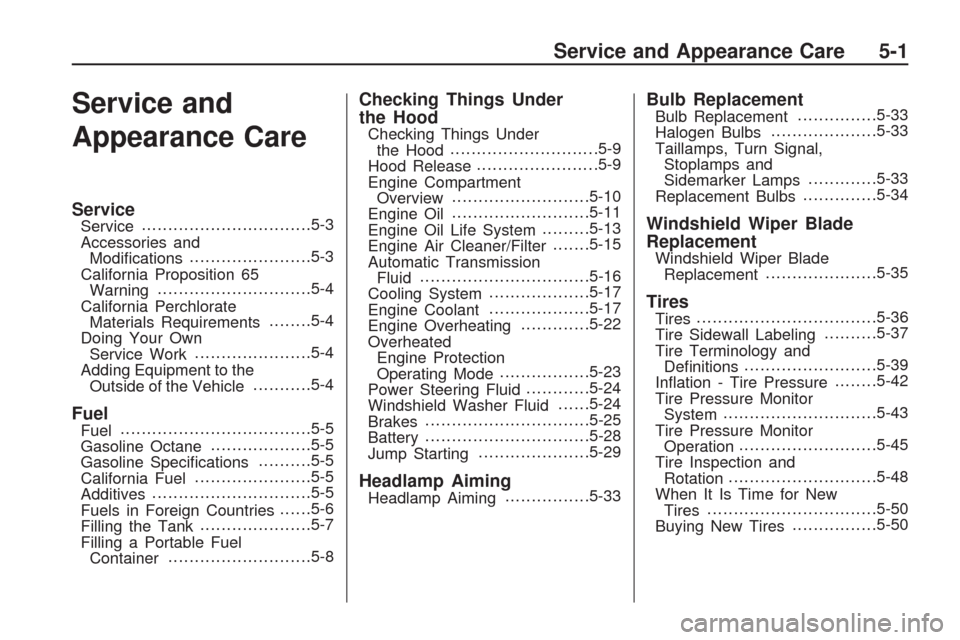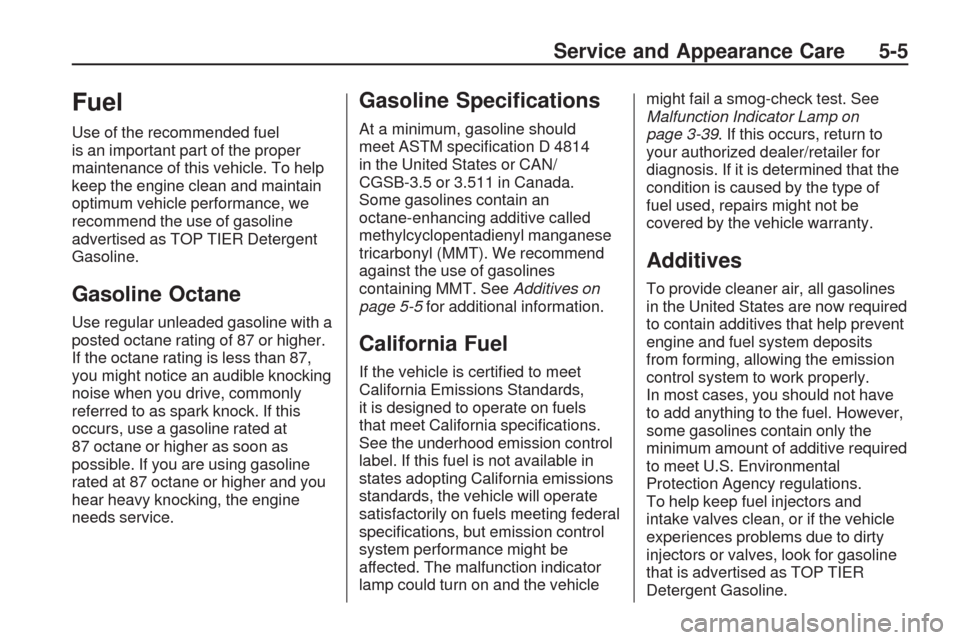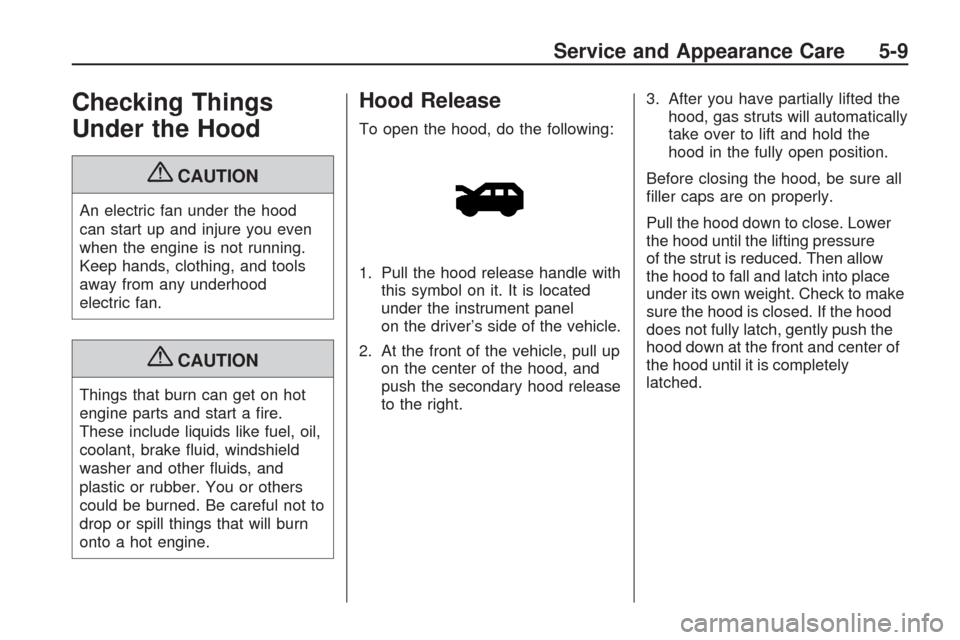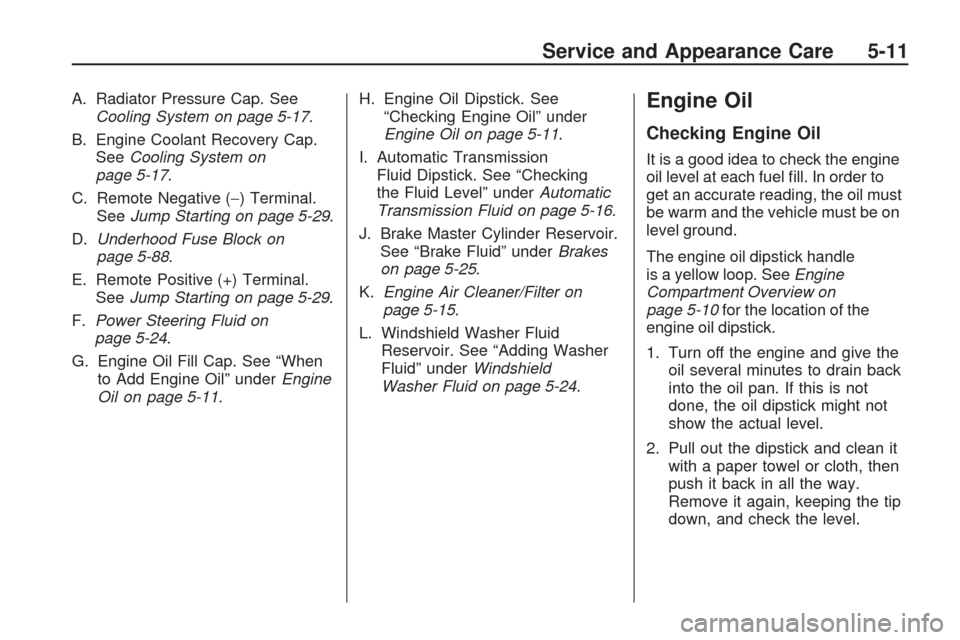check engine CHEVROLET TRAVERSE 2009 1.G Owner's Manual
[x] Cancel search | Manufacturer: CHEVROLET, Model Year: 2009, Model line: TRAVERSE, Model: CHEVROLET TRAVERSE 2009 1.GPages: 422, PDF Size: 2.06 MB
Page 279 of 422

Passing
More passing distance is needed
when towing a trailer. Because the
rig is longer, it is necessary to go
much farther beyond the passed
vehicle before returning to the lane.
Backing Up
Hold the bottom of the steering wheel
with one hand. Then, to move the
trailer to the left, move that hand to
the left. To move the trailer to the
right, move your hand to the right.
Always back up slowly and, if
possible, have someone guide you.
Making Turns
Notice:Making very sharp turns
while trailering could cause the
trailer to come in contact with the
vehicle. The vehicle could be
damaged. Avoid making very
sharp turns while trailering.When turning with a trailer, make
wider turns than normal. Do this so
the trailer won’t strike soft shoulders,
curbs, road signs, trees or other
objects. Avoid jerky or sudden
maneuvers. Signal well in advance.
Turn Signals When Towing a
Trailer
The arrows on the instrument panel
�ash whenever signaling a turn or
lane change. Properly hooked up,
the trailer lamps also �ash, telling
other drivers the vehicle is turning,
changing lanes or stopping.
When towing a trailer, the arrows on
the instrument panel �ash for turns
even if the bulbs on the trailer are
burned out. For this reason you may
think other drivers are seeing the
signal when they are not. It is
important to check occasionally to be
sure the trailer bulbs are still working.
Driving on Grades
Because of the added load of the
trailer, the vehicle’s engine may
overheat on hot days, when going up
a long or steep grade with a trailer. If
the engine coolant temperature gage
indicates overheating, turn off the air
conditioning to reduce engine load,
pull off the road and stop in a safe
spot. Let the engine run while
parked, preferably on level ground,
with the transmission in P (Park) for
a few minutes before turning the
engine off.
Reduce speed and shift to a lower
gearbeforestarting down a long or
steep downgrade. If the transmission
is not shifted down, the brakes
might have to be used so much that
they would get hot and no longer
work well.
On a long uphill grade, shift down
and reduce the vehicle speed
to around 55 mph (88 km/h) to
reduce the possibility of the engine
and the transmission overheating.
Driving Your Vehicle 4-31
Page 281 of 422

Parking on Hills
{CAUTION
Parking the vehicle on a hill with
the trailer attached can be
dangerous. If something goes
wrong, the rig could start to move.
People can be injured, and both
the vehicle and the trailer can be
damaged. When possible, always
park the rig on a �at surface.
If parking the rig on a hill:
1. Press the brake pedal, but do not
shift into P (Park) yet. Turn the
wheels into the curb if facing
downhill or into traffic if facing
uphill.
2. Have someone place chocks
under the trailer wheels.3. When the wheel chocks are in
place, release the brake pedal
until the chocks absorb the load.
4. Reapply the brake pedal. Then
apply the parking brake and shift
the transmission into P (Park).
5. Release the brake pedal.
Leaving After Parking on
a Hill
1. Apply and hold the brake pedal
while you:
start the engine,
shift into a gear, and
release the parking brake.
2. Let up on the brake pedal.
3. Drive slowly until the trailer is
clear of the chocks.
4. Stop and have someone pick up
and store the chocks.
Maintenance When Trailer
Towing
The vehicle needs service more
often when pulling a trailer. See
Scheduled Maintenance on page 6-3
for more information. Things that
are especially important in trailer
operation are automatic transmission
�uid, engine oil, axle lubricant, belts,
cooling system and brake system.
It is a good idea to inspect these
before and during the trip.
Check periodically to see that all
hitch nuts and bolts are tight.
Trailer Wiring Harness
The vehicle is equipped with the
following wiring harness for towing
a trailer.
Driving Your Vehicle 4-33
Page 283 of 422

Service and
Appearance Care
ServiceService................................5-3
Accessories and
Modi�cations.......................5-3
California Proposition 65
Warning.............................5-4
California Perchlorate
Materials Requirements........5-4
Doing Your Own
Service Work......................5-4
Adding Equipment to the
Outside of the Vehicle...........5-4
FuelFuel....................................5-5
Gasoline Octane...................5-5
Gasoline Speci�cations..........5-5
California Fuel......................5-5
Additives..............................5-5
Fuels in Foreign Countries......5-6
Filling the Tank.....................5-7
Filling a Portable Fuel
Container...........................5-8
Checking Things Under
the Hood
Checking Things Under
the Hood............................5-9
Hood Release.......................5-9
Engine Compartment
Overview..........................5-10
Engine Oil..........................5-11
Engine Oil Life System.........5-13
Engine Air Cleaner/Filter.......5-15
Automatic Transmission
Fluid................................5-16
Cooling System...................5-17
Engine Coolant...................5-17
Engine Overheating.............5-22
Overheated
Engine Protection
Operating Mode.................5-23
Power Steering Fluid............5-24
Windshield Washer Fluid......5-24
Brakes...............................5-25
Battery...............................5-28
Jump Starting.....................5-29
Headlamp AimingHeadlamp Aiming................5-33
Bulb ReplacementBulb Replacement...............5-33
Halogen Bulbs....................5-33
Taillamps, Turn Signal,
Stoplamps and
Sidemarker Lamps.............5-33
Replacement Bulbs..............5-34
Windshield Wiper Blade
Replacement
Windshield Wiper Blade
Replacement.....................5-35
TiresTires..................................5-36
Tire Sidewall Labeling..........5-37
Tire Terminology and
De�nitions.........................5-39
In�ation - Tire Pressure........5-42
Tire Pressure Monitor
System.............................5-43
Tire Pressure Monitor
Operation..........................5-45
Tire Inspection and
Rotation............................5-48
When It Is Time for New
Tires................................5-50
Buying New Tires................5-50
Service and Appearance Care 5-1
Page 286 of 422

California Proposition 65
Warning
Most motor vehicles, including this
one, contain and/or emit chemicals
known to the State of California
to cause cancer and birth defects or
other reproductive harm. Engine
exhaust, many parts and systems
(including some inside the vehicle),
many �uids, and some component
wear by-products contain and/or
emit these chemicals.
California Perchlorate
Materials Requirements
Certain types of automotive
applications, such as airbag
initiators, seat belt pretensioners,
and lithium batteries contained in
remote keyless transmitters, may
contain perchlorate materials.
Special handling may be necessary.
For additional information, see
www.dtsc.ca.gov/hazardouswaste/
perchlorate.
Doing Your Own
Service Work
{CAUTION
You can be injured and the
vehicle could be damaged if you
try to do service work on a vehicle
without knowing enough about it.
Be sure you have sufficient
knowledge, experience, the
proper replacement parts, and
tools before attempting any
vehicle maintenance task.
Be sure to use the proper
nuts, bolts, and other
fasteners. English and metric
fasteners can be easily
confused. If the wrong
fasteners are used, parts
can later break or fall off.
You could be hurt.
If doing some of your own service
work, use the proper service
manual. It tells you much moreabout how to service the vehicle
than this manual can. To order the
proper service manual, see
Service Publications Ordering
Information on page 7-15.
This vehicle has an airbag system.
Before attempting to do your
own service work, seeServicing
Your Airbag-Equipped Vehicle
on page 1-57.
Keep a record with all parts receipts
and list the mileage and the date
of any service work performed. See
Maintenance Record on page 6-16.Adding Equipment to the
Outside of the Vehicle
Things added to the outside of
the vehicle can affect the air�ow
around it. This can cause wind noise
and can affect fuel economy and
windshield washer performance.
Check with your dealer/retailer
before adding equipment to
the outside of the vehicle.
5-4 Service and Appearance Care
Page 287 of 422

Fuel
Use of the recommended fuel
is an important part of the proper
maintenance of this vehicle. To help
keep the engine clean and maintain
optimum vehicle performance, we
recommend the use of gasoline
advertised as TOP TIER Detergent
Gasoline.
Gasoline Octane
Use regular unleaded gasoline with a
posted octane rating of 87 or higher.
If the octane rating is less than 87,
you might notice an audible knocking
noise when you drive, commonly
referred to as spark knock. If this
occurs, use a gasoline rated at
87 octane or higher as soon as
possible. If you are using gasoline
rated at 87 octane or higher and you
hear heavy knocking, the engine
needs service.
Gasoline Speci�cations
At a minimum, gasoline should
meet ASTM speci�cation D 4814
in the United States or CAN/
CGSB-3.5 or 3.511 in Canada.
Some gasolines contain an
octane-enhancing additive called
methylcyclopentadienyl manganese
tricarbonyl (MMT). We recommend
against the use of gasolines
containing MMT. SeeAdditives on
page 5-5for additional information.
California Fuel
If the vehicle is certi�ed to meet
California Emissions Standards,
it is designed to operate on fuels
that meet California speci�cations.
See the underhood emission control
label. If this fuel is not available in
states adopting California emissions
standards, the vehicle will operate
satisfactorily on fuels meeting federal
speci�cations, but emission control
system performance might be
affected. The malfunction indicator
lamp could turn on and the vehiclemight fail a smog-check test. See
Malfunction Indicator Lamp on
page 3-39. If this occurs, return to
your authorized dealer/retailer for
diagnosis. If it is determined that the
condition is caused by the type of
fuel used, repairs might not be
covered by the vehicle warranty.
Additives
To provide cleaner air, all gasolines
in the United States are now required
to contain additives that help prevent
engine and fuel system deposits
from forming, allowing the emission
control system to work properly.
In most cases, you should not have
to add anything to the fuel. However,
some gasolines contain only the
minimum amount of additive required
to meet U.S. Environmental
Protection Agency regulations.
To help keep fuel injectors and
intake valves clean, or if the vehicle
experiences problems due to dirty
injectors or valves, look for gasoline
that is advertised as TOP TIER
Detergent Gasoline.
Service and Appearance Care 5-5
Page 288 of 422

For customers who do not use TOP
TIER Detergent Gasoline regularly,
one bottle of GM Fuel System
Treatment PLUS, added to the fuel
tank at every engine oil change,
can help clean deposits from fuel
injectors and intake valves. GM Fuel
System Treatment PLUS is the only
gasoline additive recommended by
General Motors.
Also, your dealer/retailer has
additives that will help correct and
prevent most deposit-related
problems.
Gasolines containing oxygenates,
such as ethers and ethanol, and
reformulated gasolines might
be available in your area. We
recommend that you use these
gasolines, if they comply with the
speci�cations described earlier.
However, E85 (85% ethanol) and
other fuels containing more than
10% ethanol must not be used in
vehicles that were not designed for
those fuels.Notice:This vehicle was not
designed for fuel that contains
methanol. Do not use fuel
containing methanol. It can
corrode metal parts in the fuel
system and also damage plastic
and rubber parts. That damage
would not be covered under
the vehicle warranty.
Some gasolines that are
not reformulated for low
emissions can contain an
octane-enhancing additive called
methylcyclopentadienyl manganese
tricarbonyl (MMT); ask the attendant
where you buy gasoline whether the
fuel contains MMT. We recommend
against the use of such gasolines.
Fuels containing MMT can reduce
the life of spark plugs and the
performance of the emission control
system could be affected. The
malfunction indicator lamp might turn
on. If this occurs, return to your
dealer/retailer for service.Fuels in Foreign
Countries
If you plan on driving in another
country outside the United States or
Canada, the proper fuel might be
hard to �nd. Never use leaded
gasoline or any other fuel not
recommended in the previous text
on fuel. Costly repairs caused
by use of improper fuel would not
be covered by the vehicle warranty.
To check the fuel availability, ask
an auto club, or contact a major oil
company that does business in
the country where you will be
driving.
5-6 Service and Appearance Care
Page 291 of 422

Checking Things
Under the Hood
{CAUTION
An electric fan under the hood
can start up and injure you even
when the engine is not running.
Keep hands, clothing, and tools
away from any underhood
electric fan.
{CAUTION
Things that burn can get on hot
engine parts and start a �re.
These include liquids like fuel, oil,
coolant, brake �uid, windshield
washer and other �uids, and
plastic or rubber. You or others
could be burned. Be careful not to
drop or spill things that will burn
onto a hot engine.
Hood Release
To open the hood, do the following:
1. Pull the hood release handle with
this symbol on it. It is located
under the instrument panel
on the driver’s side of the vehicle.
2. At the front of the vehicle, pull up
on the center of the hood, and
push the secondary hood release
to the right.3. After you have partially lifted the
hood, gas struts will automatically
take over to lift and hold the
hood in the fully open position.
Before closing the hood, be sure all
�ller caps are on properly.
Pull the hood down to close. Lower
the hood until the lifting pressure
of the strut is reduced. Then allow
the hood to fall and latch into place
under its own weight. Check to make
sure the hood is closed. If the hood
does not fully latch, gently push the
hood down at the front and center of
the hood until it is completely
latched.
Service and Appearance Care 5-9
Page 293 of 422

A. Radiator Pressure Cap. See
Cooling System on page 5-17.
B. Engine Coolant Recovery Cap.
SeeCooling System on
page 5-17.
C. Remote Negative (−) Terminal.
SeeJump Starting on page 5-29.
D.Underhood Fuse Block on
page 5-88.
E. Remote Positive (+) Terminal.
SeeJump Starting on page 5-29.
F.Power Steering Fluid on
page 5-24.
G. Engine Oil Fill Cap. See “When
to Add Engine Oil” underEngine
Oil on page 5-11.H. Engine Oil Dipstick. See
“Checking Engine Oil” under
Engine Oil on page 5-11.
I. Automatic Transmission
Fluid Dipstick. See “Checking
the Fluid Level” underAutomatic
Transmission Fluid on page 5-16.
J. Brake Master Cylinder Reservoir.
See “Brake Fluid” underBrakes
on page 5-25.
K.Engine Air Cleaner/Filter on
page 5-15.
L. Windshield Washer Fluid
Reservoir. See “Adding Washer
Fluid” underWindshield
Washer Fluid on page 5-24.Engine Oil
Checking Engine Oil
It is a good idea to check the engine
oil level at each fuel �ll. In order to
get an accurate reading, the oil must
be warm and the vehicle must be on
level ground.
The engine oil dipstick handle
is a yellow loop. SeeEngine
Compartment Overview on
page 5-10for the location of the
engine oil dipstick.
1. Turn off the engine and give the
oil several minutes to drain back
into the oil pan. If this is not
done, the oil dipstick might not
show the actual level.
2. Pull out the dipstick and clean it
with a paper towel or cloth, then
push it back in all the way.
Remove it again, keeping the tip
down, and check the level.
Service and Appearance Care 5-11
Page 296 of 422

When the system has calculated
that oil life has been diminished,
it indicates that an oil change is
necessary. A CHANGE ENGINE OIL
SOON message comes on. Change
the oil as soon as possible within
the next 600 miles (1 000 km). It is
possible that, if driving under the best
conditions, the oil life system might
not indicate that an oil change is
necessary for over a year. However,
the engine oil and �lter must be
changed at least once a year and at
this time the system must be reset.
Your dealer/retailer has trained
service people who will perform this
work using genuine parts and reset
the system. It is also important to
check the oil regularly and keep it at
the proper level.If the system is ever reset
accidentally, the oil must be
changed at 3,000 miles (5 000 km)
since the last oil change. Remember
to reset the oil life system whenever
the oil is changed.
How to Reset the Engine Oil
Life System
The Engine Oil Life System
calculates when to change the
engine oil and �lter based on vehicle
use. Whenever the oil is changed,
reset the system so it can calculate
when the next oil change is required.
If a situation occurs where the oil
is changed prior to a CHANGE
ENGINE OIL SOON message being
turned on, reset the system.If the vehicle does not have Driver
Information Center (DIC) buttons:
1. Turn the ignition to ON/RUN, with
the engine off. The vehicle must
be in P (Park) to access this
display. Press the trip odometer
reset stem until OIL LIFE
REMAINING displays.
2. Press and hold the trip
odometer reset stem until OIL
LIFE REMAINING shows 100%.
Three chimes sound and the
CHANGE ENGINE OIL SOON
message goes off.
3. Turn the key to LOCK/OFF.
If the CHANGE ENGINE OIL
SOON message comes back on
when the vehicle is started, the
engine oil life system has not
reset. Repeat the procedure.
5-14 Service and Appearance Care
Page 298 of 422

To inspect or replace the engine air
cleaner/�lter:
1. Loosen the screws that hold the
cover on.
2. Disconnect the electrical
connector.
3. Lift off the cover.
4. Remove the engine air cleaner/
�lter element and any loose
debris that may be found in the
air cleaner base.5. Inspect or replace the air �lter
element.
6. Reverse Steps 1 through 3 to
reinstall the cover and reconnect
the electrical connector.
{CAUTION
Operating the engine with the air
cleaner/�lter off can cause you
or others to be burned. The air
cleaner not only cleans the air; it
helps to stop �ames if the engine
back�res. If it is not there and the
engine back�res, you could be
burned. Do not drive with it off, and
be careful working on the engine
with the air cleaner/�lter off.
Notice:If the air cleaner/�lter
is off, a back�re can cause a
damaging engine �re. And, dirt
can easily get into the engine,
which will damage it. Always have
the air cleaner/�lter in place when
you are driving.
Automatic Transmission
Fluid
It is not necessary to check
the transmission �uid level.
A transmission �uid leak is the
only reason for �uid loss. If a leak
occurs, take the vehicle to the
dealer/retailer and have it repaired
as soon as possible.
Change the �uid at the intervals
listed inAdditional Required Services
on page 6-6, and be sure to use
the transmission �uid listed in
Recommended Fluids and
Lubricants on page 6-12.
Notice:Use of the incorrect
automatic transmission �uid may
damage the vehicle, and the
damages may not be covered by
the vehicle’s warranty. Always
use the automatic transmission
�uid listed inRecommended
Fluids and Lubricants on
page 6-12.
5-16 Service and Appearance Care